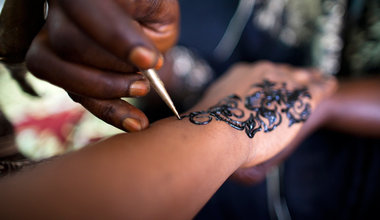13 May
2013
Culture
Ephemeral Craft: An Interview with Henna Artist Fatima Mohamed
Henna, a temporary art form, has long been used to enhance personal style or make a fashion statement. In the conflict-torn region of Darfur, the craft is serving to bring people closer together.
By Ala Mayyahi
Henna is one of the most popular personal art forms in Darfur. Local women use henna mainly for beautification, especially in preparation for weddings or similar auspicious occasions, such as the Eid holidays. Henna artists, locally called hannana, are not difficult to find in Darfur, but there are a few who have a reputation in the area as being among the best in their profession.
Ms. Fatima Mohamed, known to her friends and clients as Tata, is one of the most popular henna artists in Darfur. Her reputation extends to Khartoum and even outside Sudan to places such as Dubai and Abu Dhabi in the United Arab Emirates, where she frequently travels to serve her clients.
Born in 1979 in El Fasher, North Darfur, Ms. Tata spent her childhood years in her hometown. Afterward, she moved with her parents to Khartoum, where she finished high school, then returned to El Fasher. In 1997, Ms. Tata went again to Khartoum and studied accounting at the university level for two years, but her passion for the art of henna was already taking her away from finance.
Currently, she is dedicated full-time to henna. She says her talent is in such high demand that she is able to support her parents and her 10 siblings. Voices of Darfur talked with Ms. Tata about her craft, its artistic and social aspects, and what it means to the people of Darfur.
[...]
Read the full interview in the May issue of Voices of Darfur. Download the magazine (PDF) here.


On 30 March 2013 in El Fasher, North Darfur, Ms. Fatama Mohamed, draws henna on a client’s hand. Photo by Albert González Farran, UNAMID.
 UN
UN United Nations Peacekeeping
United Nations Peacekeeping





